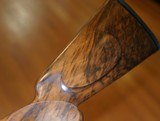 |
 |
 |
 |
 |
 |
 |
 |
 |
 |
 |
 |
 |

MAUSER SQUARE BRIDGE .416 RIGBY
Guns International #: 101246073 Seller's Inventory #: 162211
Category: Mauser Rifles - Sporter Post-War - Rifles - African Dangerous Game Safari Magazine
Seller's Information
When emailing or calling sellers direct, please mention that you saw their listing on GunsInternational.com
Seller: Carolina Sporting Arms
Company: Carolina Sporting Arms
Member Since: 9/18/07
First Name: CHRIS
Last Name: SHOULARS
State: North Carolina
Zip: 28273
Country: United States
Phone: (704) 554-9511
Fax: (704) 554-9551
Platinum Seller
Number of Active Listings: 30
Total Number of Listings: 8517
Seller: FFL Dealer
Return Policy: 3 day inspection and return policy on used guns.
NO LAYAWAYS
Payment Types Accepted: NO CREDIT CARD FEE
Description:
Built in 2000 on a true magnum length action, double square bridge with inletted EAW QR mounts. New condition, complete with sturdy iron sights and barrel mounted sling swivel. Comes with EAW QR 30mm rings
As new condition,great balance 9.5lbs
"Two major developments at the turn of the 20th century set the course for the development of the .416 Rigby as a successful rifle cartridge. The first was the development of cordite in the United Kingdom in 1889 and the development in Germany of the Gewehr 98 magazine rifle.
Prior to the invention of cordite, rifles used gunpowder (black powder) as a propellant. Due to the burn characteristics of black powder it did not produce high pressures and therefore did not produce high velocities. Big-bore cartridges of the era were the 4-bore, 6-bore and 8-bore rifles cartridges. Sub 12.7-millimetre (0.50 in) caliber were considered small-bore cartridges. Although the 4 bore, 6 bore and 8 bore cartridges were considered appropriate for dangerous game during that era, these cartridges lacked the penetration required to take heavy thick-skinned game such as elephant, buffalo or rhinoceros humanely. The development of smokeless powder revolutionized the rifle. One version of this smokeless powder developed in the U.K. was cordite which allowed higher pressures to be developed and thereby increasing the velocity of bullets. The invention of smokeless powder rendered the big bore rifles of the era obsolete. With the emergence of cordite as a propellant what was considered a big bore cartridge changed to any cartridge having a caliber of over 11.6 millimetres (0.458 in). The switch during World War I to modern smokeless powders would cause what constituted a big bore to be further refined to mean any cartridge over 10.2 millimetres (0.400 in).
The next improvement was the development of the Gewehr 98 rifle by Paul Mauser. Paul Mauser did not invent the bolt-action rifle but rather he refined the design allowing controlled round feeding, magazine feeding using a stripper clip, and a strong action with the ability to withstand high pressures generated by the new smokeless powders. The rifle design would go on to become the most common and successful rifle design in the history of firearms. During World War II most Axis and Allied nations with the exception of the British (Lee–Enfield), and the Russians (Mosin–Nagant) used rifles based on the Mauser 98 action. Today this is still the most popular rifle design and is used to this day by Mauser, Dumoulin-Herstal, CZ, Holland & Holland, Kimber, Rigby, Ruger and Winchester among others. The Mauser 98 action provided the consumers and gun makers an inexpensive alternative to the double and single shot rifles which until that time predominated the dangerous game hunting scene."
SOLD